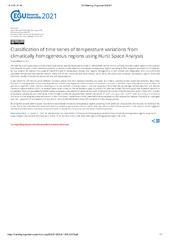Приказ основних података о документу
Classification of time series of temperature variations from climatically homogeneous regions using Hurst Space Analysis
| dc.creator | Blesić, Suzana | |
| dc.creator | Sarvan, Darko | |
| dc.creator | Tošić, Milica | |
| dc.creator | Borovinić, Marko | |
| dc.date.accessioned | 2023-03-16T09:00:27Z | |
| dc.date.available | 2023-03-16T09:00:27Z | |
| dc.date.issued | 2021 | |
| dc.identifier.uri | https://vet-erinar.vet.bg.ac.rs/handle/123456789/2703 | |
| dc.description.abstract | We used the Hurst Space Analysis (HSA), a technique that we recently developed to cluster or differentiate records from an arbitrary complex system based on the presence and influence of cycles in their statistical functions, to classify climatic data from climatically homogeneous regions according to their long-term persistent (LTP) character. For our analysis we selected four types of HadCRUT4 cells of temperature records over regions homogeneous in both climate and topography, which are sufficiently populated with ground observational stations. These cells bound: Pannonian and West Siberian plains, Rocky Mountains and Himalayas mountainous regions, Arctic and sub-Arctic climates of Island and Alaska, and Gobi and Sahara deserts. | sr |
| dc.language.iso | en | sr |
| dc.rights | openAccess | sr |
| dc.rights.uri | https://creativecommons.org/licenses/by/4.0/ | |
| dc.source | EGU General Assembly 2021, 19-30 April 2021 online (pp. EGU21-238) | sr |
| dc.title | Classification of time series of temperature variations from climatically homogeneous regions using Hurst Space Analysis | sr |
| dc.type | conferenceObject | sr |
| dc.rights.license | BY | sr |
| dc.identifier.doi | 10.5194/egusphere-egu21-238 | |
| dc.identifier.fulltext | http://veterinar.vet.bg.ac.rs/bitstream/id/7801/bitstream_7801.pdf | |
| dc.type.version | publishedVersion | sr |

